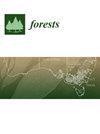澳大利亚混交林和林地再造林的碳捕集现场模拟比较
IF 2.4
2区 农林科学
Q1 FORESTRY
引用次数: 0
摘要
在过去的两个世纪中,澳大利亚大片的天然林地被砍伐,剩余的林地也因人为干预和人为气候变化而退化。因此,恢复林地是政府和社会的当务之急。碳市场为毁林林地的植被重建提供了越来越多的资金,而对林地碳捕获量的准确预测是林地恢复决策的关键一步。我们将使用 IPCC 第 2 级建模方法和澳大利亚碳核算模型 FullCAM 对地面生物量中碳含量的预测与地面测量的独立验证数据进行了比较。IPCC 第 2 级建模方法(此处称为 FastTrack 模型)经过调整,可模拟混交林在三种种植配置下的碳捕获量:直接播种、管畜种植和混合种植。为了验证模型,我们收集了 20 个种植区(n = 6044 棵树)9-35 年树龄范围内的地上生物量、树冠半径和树冠覆盖率数据。在三种种植配置中,FastTrack 模型的偏差为 2.4 吨碳/公顷(观测平均 AGB 的 +4.2%),而 FullCAM 的偏差为 -24.6 吨碳/公顷(观测平均 AGB 的 -42.9%)。根据评估的拟合优度指标,FastTrack 中约有三分之二的误差属于非系统误差,FullCAM 中约有四分之一的误差属于非系统误差。不同种植配置的模型偏差差异很大。对于 FastTrack 模型,我们发现通过不同年份的卫星图像估算出的额外冠层覆盖数据可以改善碳捕获预测。为了在现场水平上达到最高的碳预测精度,我们建议使用根据当地代表性数据对特定种植配置的参数进行校准的模型。本文章由计算机程序翻译,如有差异,请以英文原文为准。
Site-Level Modelling Comparison of Carbon Capture by Mixed-Species Forest and Woodland Reforestation in Australia
Large areas of Australia’s natural woodlands have been cleared over the last two centuries, and remaining woodlands have experienced degradation from human interventions and anthropogenic climate change. Restoration of woodlands is thus of high priority both for government and society. Revegetation of deforested woodlands is increasingly funded by carbon markets, with accurate predictions of site-level carbon capture an essential step in the decision making to restore. We compared predictions of carbon in above-ground biomass using both the IPCC Tier 2 modelling approach and Australia’s carbon accounting model, FullCAM, to independent validation data from ground-based measurements. The IPCC Tier 2 approach, here referred to as the FastTrack model, was adjusted to simulate carbon capture by mixed-species forests for three planting configurations: direct seeding, tubestock planting, and a mix thereof. For model validation, we collected data on above-ground biomass, crown radius, and canopy cover covering an age range of 9–35 years from 20 plantings (n = 6044 trees). Across the three planting configurations, the FastTrack model showed a bias of 2.4 tC/ha (+4.2% of the observed mean AGB), whilst FullCAM had a bias of −24.6 tC/ha (−42.9% of the observed mean AGB). About two-thirds of the error was partitioned to unsystematic error in FastTrack and about one-quarter in FullCAM, depending on the goodness-of-fit metric assessed. Model bias differed strongly between planting configurations. For the FastTrack model, we found that additional canopy cover data estimated from satellite images obtained at different years can improve the carbon capture projections. To attain the highest accuracy of carbon projection at the site level, we recommend using a model with parameters calibrated for the specific planting configuration using local representative data.
求助全文
通过发布文献求助,成功后即可免费获取论文全文。
去求助
来源期刊

Forests
FORESTRY-
CiteScore
4.40
自引率
17.20%
发文量
1823
审稿时长
19.02 days
期刊介绍:
Forests (ISSN 1999-4907) is an international and cross-disciplinary scholarly journal of forestry and forest ecology. It publishes research papers, short communications and review papers. There is no restriction on the length of the papers. Our aim is to encourage scientists to publish their experimental and theoretical research in as much detail as possible. Full experimental and/or methodical details must be provided for research articles.
 求助内容:
求助内容: 应助结果提醒方式:
应助结果提醒方式:


